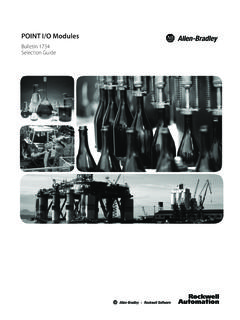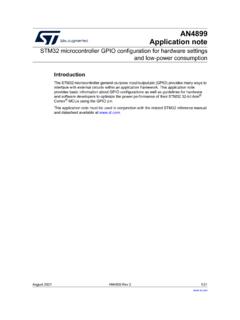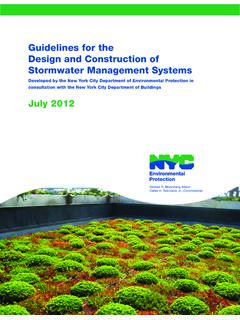Transcription of Guidelines on firewalls and firewall policy
1 Special Publication 800-41 Revision 1 Guidelines on firewalls and firewall policy Recommendations of the National Institute of Standards and Technology Karen Scarfone Paul Hoffman Guidelines on firewalls and firewall policy Recommendations of the National Institute of Standards and Technology Karen Scarfone Paul Hoffman NIST Special Publication 800-41 Revision 1 C O M P U T E R S E C U R I T YComputer Security Division Information Technology Laboratory National Institute of Standards and Technology Gaithersburg, MD 20899-8930 September 2009 Department of Commerce Gary Locke, Secretary National Institute of Standards and Technology Patrick D.
2 Gallagher, Deputy Director Guidelines ON firewalls AND firewall policy Reports on Computer Systems Technology The Information Technology Laboratory (ITL) at the National Institute of Standards and Technology (NIST) promotes the economy and public welfare by providing technical leadership for the nation s measurement and standards infrastructure. ITL develops tests, test methods, reference data, proof of concept implementations, and technical analysis to advance the development and productive use of information technology. ITL s responsibilities include the development of technical, physical, administrative, and management standards and Guidelines for the cost-effective security and privacy of sensitive unclassified information in Federal computer systems.
3 This Special Publication 800-series reports on ITL s research, guidance, and outreach efforts in computer security and its collaborative activities with industry, government, and academic organizations. Certain commercial entities, equipment, or materials may be identified in this document in order to describe an experimental procedure or concept adequately. Such identification is not intended to imply recommendation or endorsement by the National Institute of Standards and Technology, nor is it intended to imply that the entities, materials, or equipment are necessarily the best available for the purpose. National Institute of Standards and Technology Special Publication 800-41 Revision 1 Natl.
4 Inst. Stand. Technol. Spec. Publ. 800-41 rev1, 48 pages (Sep. 2009) iiiGUIDELINES ON firewalls AND firewall policy Acknowledgments The authors, Karen Scarfone of the National Institute of Standards and Technology (NIST) and Paul Hoffman of the Virtual Private Network Consortium, wish to thank their colleagues who reviewed drafts of this document and contributed to its technical content. The authors would like to acknowledge Tim Grance, Murugiah Souppaya, Sheila Frankel, and Gale Richter of NIST, and Matthew Goche, David Klug, Logan Lodge, John Pearce, Noel Richards, Anne Roudabush, and Steven Sharma of Booz Allen Hamilton, for their keen and insightful assistance throughout the development of the document.
5 Special thanks go to Brahim Asfahani of Booz Allen Hamilton for his contributions to early drafts of the document. The authors also thank all the reviewers who provided feedback during the public comment period, particularly Joel Snyder (Opus One), Ron Colvin (National Aeronautics and Space Administration [NASA]), Dean Farrington (Wells Fargo), Raffael Marty (Splunk), and David Newman (Network Test). The authors also wish to express their thanks to the individuals and organizations that contributed to the original version of the publication, including John Wack of NIST and Ken Cutler and Jamie Pole of the MIS Training Institute, who authored the original version, and other contributors and reviewers particularly Peter Batista and Wayne Bavry ( Treasury); Harriet Feldman (Integrated Computer Engineering, Inc.)
6 ; Rex Sanders ( Geological Survey); and Timothy Grance, D. Richard Kuhn, Peter Mell, Gale Richter, and Murugiah Souppaya (NIST). ivGUIDELINES ON firewalls AND firewall policy Table of Contents Executive ES-1 1. Authority ..1-1 Purpose and Document 2. Overview of firewall firewall Packet Stateful Application Application-Proxy Dedicated Proxy Virtual Private Network Access Unified Threat Management (UTM)..2-9 Web Application firewalls for Virtual firewalls for Individual Hosts and Home Host-Based firewalls and Personal Personal firewall Limitations of firewall Summary of 3. firewalls and Network Network Layouts with firewalls Acting as Network Address Architecture with Multiple Layers of Summary of 4.
7 firewall Policies Based on IP Addresses and IP Addresses and Other IP TCP and IPsec Policies Based on Policies Based on User Policies Based on Network Summary of 5. firewall Planning and Configure ..5-4 Hardware and Software vGUIDELINES ON firewalls AND firewall policy policy Logging and Alerts Configuration ..5-5 List of Appendices Appendix A Glossary .. A-1 Appendix B Acronyms and B-1 Appendix C C-1 List of Figures Figure 2-1. TCP/IP Layers ..2-1 Figure 2-2. Application Proxy Figure 3-1. Simple Routed Network with firewall Figure 3-2. firewall with a DMZ ..3-2 List of Tables Table 2-1.
8 State Table viGUIDELINES ON firewalls AND firewall policy Executive Summary firewalls are devices or programs that control the flow of network traffic between networks or hosts that employ differing security postures. At one time, most firewalls were deployed at network perimeters. This provided some measure of protection for internal hosts, but it could not recognize all instances and forms of attack, and attacks sent from one internal host to another often do not pass through network firewalls . Because of these and other factors, network designers now often include firewall functionality at places other than the network perimeter to provide an additional layer of security, as well as to protect mobile devices that are placed directly onto external networks.
9 Threats have gradually moved from being most prevalent in lower layers of network traffic to the application layer, which has reduced the general effectiveness of firewalls in stopping threats carried through network communications. However, firewalls are still needed to stop the significant threats that continue to work at lower layers of network traffic. firewalls can also provide some protection at the application layer, supplementing the capabilities of other network security technologies. There are several types of firewalls , each with varying capabilities to analyze network traffic and allow or block specific instances by comparing traffic characteristics to existing policies.
10 Understanding the capabilities of each type of firewall , and designing firewall policies and acquiring firewall technologies that effectively address an organization s needs, are critical to achieving protection for network traffic flows. This document provides an overview of firewall technologies and discusses their security capabilities and relative advantages and disadvantages in detail. It also provides examples of where firewalls can be placed within networks, and the implications of deploying firewalls in particular locations. The document also makes recommendations for establishing firewall policies and for selecting, configuring, testing, deploying, and managing firewall solutions.














